Ms Pacman Game Boy Color Color Box Art
- For other uses of Ms. Pac-Man, see Ms. Pac-Man (disambiguation).
Ms. Pac-Man (ミズパックマン Mizu Pakkuman) is the second game in the Pac-Man series, released in 1982 by Bally Midway.
Contents
- 1 Gameplay Info
- 1.1 Scoring System
- 2 Development History
- 3 Home Ports
- 4 Other versions
- 5 Namco Museum port
- 6 Play Online
- 7 Trivia
- 8 Gallery
- 8.1 Screenshots
- 8.2 Concept Artwork
- 8.3 Machine and Box Art
- 8.4 Character Artwork
- 9 External links
- 10 References
Gameplay Info
The goal of the game is to have Ms. Pac-Man eat all of the on-screen dots and avoid the attacks of the four ghosts. The gameplay follows the same premise as Pac-Man, although there are some key differences:
- The game has four different colorful mazes that alternate. The orange maze appears in levels 1 and 2, the light blue maze appears in levels 3, 4, and 5, the brown maze appears in levels 6 through 9, and the dark blue maze appears in levels 10 through 13. Starting with level 14, the last two maze configurations alternate between each other every 4th level.
- The Fruits are now cherries, strawberries, oranges, pretzels, apples, pears, and bananas, respectively. After the banana appears, the fruit prizes are chosen at random.
- The fruit bounces around the screen instead of remaining stationary below the ghost pen, starting from one of the tunnel entrances and leaving through another if not eaten.
- The intermissions have been changed to "Acts". The first one shows how Pac-Man and Ms. Pac-Man first meet, the second shows the two chasing each other around the screen, and the third shows Pac-Man and Ms. Pac-Man awaiting the arrival of Junior.
- The orange ghost (originally named "Clyde") is now named "Sue".
- The ghosts do not move in "scatter" and "chase" cycles as they did in the original game; Blinky and Pinky will move randomly and Inky and Sue will head for their "scatter" corners only during first behavior mode of a round. From there, while they will change direction occasionally, they will remain in constant attack.
- There are no longer any paths that the ghosts cannot travel through.
- Tunnels do not slow the ghosts down after Round 3.
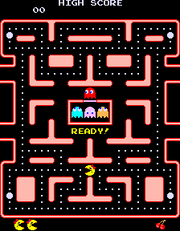
The original maze.
Scoring System
- Pac-Dot - 10 points.
- Power Pellet - 50 points.
- Vulnerable Ghosts:
- #1 in succession - 200 points.
- #2 in succession - 400 points.
- #3 in succession - 800 points.
- #4 in succession - 1600 points.
- Fruit:
- 🍒 Cherry: 100 points.
- 🍓 Strawberry: 200 points
- 🍊 Orange: 500 points
- 🥨 Pretzel: 700 points
- 🍎 Apple: 1000 points
- 🍐 Pear: 2000 points
- 🍌 Banana: 5000 points
Development History
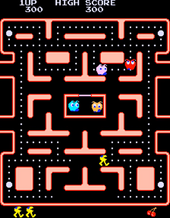
Screenshot from a fan-made hack, recreating Crazy Otto.
Originally, Ms. Pac-Man started as an unauthorized hack of Pac-Man called Crazy Otto by General Computer Corporation, featuring a Pac-Man-like character with a blue eye and legs. To avoid another lawsuit with Atari (which they had previously received for creating "Super Missile Attack", a Missile Command hack), G.C.C. presented the game to Bally Midway for approval of release. Midway, impatient for Namco to release the then-upcoming Super Pac-Man, purchased Crazy Otto for their own release.
After acquiring the game, Midway changed a quantity of details from Crazy Otto (some of which were at Namco founder Masaya Nakamura's request), going through several internal prototypes. The first of these was titled "Super Pac-Man" - unrelated to the Namco-developed game - which used the same character graphics as the original Pac-Man. Following this was "Pac-Woman", which starred a female Pac-Man with red hair. The Pac-Woman prototype was shown to Nakamura, who reportedly responded "Love the concept, get rid of the hair". After this, the final character design for Ms. Pac-Man was created. Another, lesser-known change is that, in Crazy Otto, the ghost's eyes did not appear after being eaten with a power pellet; this feature was added back in Ms. Pac-Man.
Ms. Pac-Man arcade machines were scheduled to enter production in quarter 4 of 1981. However, there was an internal conflict between whether the game should be titled "Miss", "Mrs.", or "Ms." Pac-Man; eventually, the latter was chosen. This delayed the release by several months, with production starting in February 1982 as opposed to '81. The game still says 1981 on the title screen, though this was changed to 1982 in some home console ports.
As Ms. Pac-Man (in its Crazy Otto form) was initially developed without Namco's permission, Bally Midway later turned the intellectual property rights to the game over to Namco. Ms. Pac-Man was never released in any arcade form in Japan, and would not receive a Japanese home console release until 1990 on the Atari Lynx.[1] [2]
Home Ports
- Android
- Apple II
- Arcade1UP Machines
- Many Arcade1UPs featuring Ms. Pac-Man have been released (see this page for full list).
- Atari 400/800/XL/XE
- Atari 2600
- Mazes are slightly different than the original.
- Atari 5200
- Atari 7800
- Atari Lynx
- Features a unique set of mazes not found in other versions.
- A new intermission titled "Bus Stop" was added.
- Commodore 64
- Commodore VIC-20
- Famicom/NES
- Two versions were released. The first was in 1990 by Tengen, which added many new mazes and options, in addition to a two-player cooperative mode (see this page for more information). A different port by Namco Hometek was released in 1993, which is commonly considered inferior to Tengen's version.
- The Tengen 1990 version adds an ending after Level 32.
- The Namco 1993 version features different colors for the mazes than the original game.
- Two versions were released. The first was in 1990 by Tengen, which added many new mazes and options, in addition to a two-player cooperative mode (see this page for more information). A different port by Namco Hometek was released in 1993, which is commonly considered inferior to Tengen's version.
- Game Boy
- Game Boy Color
- Released as Ms. Pac-Man: Special Color Edition, which also included Super Pac-Man.
- Same port as the original Game Boy version, only colorized.
- Game Boy Advance
- Two versions were released, which were included in Namco Museum and Namco Museum 50th Anniversary; both compilations have the game emulated slightly differently from each other.
- GameCube
- Three versions were released. The game was included inNamco Museum andNamco Museum 50th Anniversary, and was featured as a bonus game inPac-Man World 2.
- Game Gear
- Features different colors for the mazes than the original game.
- Handheld LCD Games
- Many different handheld LCD games have been released, the earliest being the Orlitronic "shaped" handheld from 1984.
- The ports included greatly vary between units. The majority of earlier systems took creative liberties when porting the game, and feature many differences when compared to the original. Later consoles (such as the MGA "Classic Arcade" version) are much more accurate conversions.
- Most Ms. Pac-Man LCD games are in black-and-white, but a handful were in color.
- IBM PC
- Supports CGA composite mode for additional colors.[3]
- iOS (iPhone, iPad, etc.)
- iPod Classic
- Mobile
- Nintendo 64
- Two identical versions were released, which were included in Namco Museum 64 and Ms. Pac-Man Maze Madness.
- Phillips CD-i
- Included in Arcade Classics.
- Similar to the Tengen releases, featuring many options and a two-player cooperative mode, in addition to many new mazes (which are exclusive to this release).
- Features different colors for the mazes than the original game.
- PlayStation
- Two identical versions were released, which were included in Namco Museum Vol. 1 and Ms. Pac-Man Maze Madness.
- PlayStation 2
- Three versions were released. The game was included inNamco Museum andNamco Museum 50th Anniversary, and was featured as a bonus game inPac-Man World 2.
- PlayStation 3
- Three versions were released. There were two PS one Classics versions:Namco Museum Vol. 3 andMs. Pac-Man Maze Madness, both of which feature the original game. It was later released as paid DLC for Pac-Man Museum.
- PlayStation 4
- Released as a standalone digital release titled Arcade Game Series: Ms. Pac-Man.
- PlayStation Portable
- Three versions were released. The game was included inNamco Museum Battle Collection (Namco Museum 1 in Japan); it was not included in the Korean release of the game. There were two PS one Classics versions:Namco Museum Vol. 3 andMs. Pac-Man Maze Madness, both of which feature the original game.
- PlayStation Vita
- Two versions were released via PS one Classics: Namco Museum Vol. 3 andMs. Pac-Man Maze Madness, both of which feature the original game.
- Plug 'N Play TV Games
- Many different Plug 'N Plays featuringMs. Pac-Man have been released (see this page for full list), the earliest beingMs. Pac-Man Collection from 2004.
- The original systems were released by Jakks Pacific, and featured a port very close to the arcade version. Consoles from the 2010s onward were from different manufacturers, and often feature the Namco 1993 NES version.
- Pocket Player (My Arcade)
- Included in theMs. Pac-Man Pocket Player.
- Features the Namco 1993 NES version.
- Sega Master System
- Features all modes and options from the Tengen 1990 NES version, in addition to overhauled graphics.
- Features different colors for the mazes than the original game.
- Sega Genesis/Mega Drive
- Two versions were released. The first was a single-cartridge version, which features all modes and options from the Tengen 1990 NES version, in addition to overhauled graphics. A different port was later included as a bonus game in Pac-Man 2: The New Adventures; here it was rebranded as Pac-Jr., a modified version of Ms. Pac-Man that slightly changes the mazes and stars Jr. Pac-Man.
- Pac-Jr. is similar to the Namco 1993 NES version of Ms. Pac-Man, but features slightly updated graphics and a high-score table.
- Two versions were released. The first was a single-cartridge version, which features all modes and options from the Tengen 1990 NES version, in addition to overhauled graphics. A different port was later included as a bonus game in Pac-Man 2: The New Adventures; here it was rebranded as Pac-Jr., a modified version of Ms. Pac-Man that slightly changes the mazes and stars Jr. Pac-Man.
- Sega Dreamcast
- Two identical versions were released, which were included in Namco Museum and Ms. Pac-Man Maze Madness.
- Super Famicom/SNES
- Two versions were released. Ms. Pac-Man was included as a bonus game in Pac-Man 2: The New Adventures; unlike the Genesis port, it does not change any aspects of the original. A different port on a standalone cartridge was released in 1996, which is nearly identical to the Sega Genesis/Mega Drive port.
- The Pac-Man 2 version is similar to the Namco 1993 NES version, but features slightly updated graphics and a high-score table.
- Two versions were released. Ms. Pac-Man was included as a bonus game in Pac-Man 2: The New Adventures; unlike the Genesis port, it does not change any aspects of the original. A different port on a standalone cartridge was released in 1996, which is nearly identical to the Sega Genesis/Mega Drive port.
- Tabletop Arcade Machines
- Many different tabletop arcade machines have been released, the earliest being the Coleco Tabletop from 1983.
- Following the Coleco Tabletop, no other tabletops were released up until the late 2010s. More recent consoles often either feature the Namco 1993 NES version (ex:Ms. Pac-Man Micro Player) or use a custom port loosely resembling the arcade version (ex:Arcade Classics - Ms. Pac-Man).
- TI-99/4A
- Wii U
- Released for the Virtual Console in Namco Museum (Game Boy Advance).
- Windows PC
- Released as a standalone digital release titled Arcade Game Series: Ms. Pac-Man.
- Numerous conversions were released, from Windows 95 to Windows 10. The earliest of these wereMicrosoft Revenge of Arcade and Namco History Vol. 3, both from 1998.
- Due to the more powerful architecture of computers compared to consoles at the time, all ports were straight emulations of the arcade version, with little to no differences (the only exception being the bonus version included inPac-Man World 2).
- Xbox
- Four versions were released. A single-disc version was released, often referred to as the Xbox Live Arcade Disc (although the cover just says "Arcade"), which was intended to be a demo for the Xbox Live service. The game was included inNamco Museum andNamco Museum 50th Anniversary, and was featured as a bonus game inPac-Man World 2.
- Xbox 360
- Three versions were released. The game was released as a standalone digital release through the Xbox Live service. It was also included inNamco Museum Virtual Arcade (in which it is the same as the Xbox Live version). It was later released as paid DLC for Pac-Man Museum.
- You can also get a picture pack for this game (Meaning profile pictures) scroll down to see.
- Xbox One
- Released as a standalone digital release titled Arcade Game Series: Ms. Pac-Man.
- ZX Spectrum
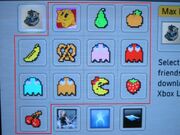
Picture Pack
A handful of Ms. Pac-Man ports by Atarisoft to other systems were planned, but were never released. These include the ColecoVision, Intellivision, BBC Micro, and IBM PCjr.[4]
Homebrew versions of Ms. Pac-Man have also been released for the ColecoVision and Intellivision.
Other versions
There are many variations of Ms. Pac-Man that are fundamentally the same as the original game, but feature several differences that make them stand out. These games include:
- Ms. Pac-Man Plus
- Ms. Pac-Man (speed-up chip)
- Ms. Pac-Man (Tengen)
- Pac-Jr.
- Ms. Pac-Man (Galaxy Games StarPak 2)
- Ms. Pac-Man for Prizes
Namco Museum port
Similarly to Pac-Man, Ms. Pac-Man also saw a Namco Museum port in 1996. This version, like Pac-Man, used the source code from the original game and was perhaps the most frequently ported version for quite some time. Some things about it were changed however, and this version sees all of the applicable changes Pac-Man had, plus:
- Blinky and Pinky do not move randomly during the first behavior mode; they head to their original "scatter" corners as they did in Pac-Man.
- Furthermore, the "scatter" and "chase" cycles are restored in the game.
- The tunnel slowdown effect does not occur until a ghost reaches middle of the tunnel (in the original game, they are slowed down at the entrance).
- The tunnel slowdown occurs in all rounds.
- Most of the sound samples have their pitch raised.
- The background sound effect does not change as the player gets closer to finishing the maze.
Play Online
These versions ofMs. Pac-Man are either listed in the public domain or are considered abandonware. Clicking the game title will lead you to a playable online version of it from archive.org (mobile compatibility may vary).
- Recommended: Super ABC (Pac-Man multigame kit) (Arcade, 1999)
- Recommended: Ms. Pac PC (MS-DOS, 1995)
- Recommended: Champ Ms. Pac-em (MS-DOS, 1996)
- Ms. Chomp (Windows 3.1, 1992)
- Ms. Pac-Man (Atari 400/800/XL/XE, 1983)
- Ms. Pac-Man (Coleco) (Tabletop Arcade Machine, 1983)
- Pac-Man Collection (ColecoVision, 2008)
- Ms. Pac-Man (Game Gear, 1993)
- Ms. Pac-Man (IBM PC, 1983)
- Ms. Pac-Man (Sega Master System, 1990)
Trivia
- Starting in 2008 after a court case, General Computer Corporation began to receive expensive royalties from Namco for most Ms. Pac-Man re-releases, including arcade machines and home console/mobile ports. This has led to (Bandai) Namco practically abandoning using the Ms. Pac-Man game altogether. However, some re-releases occur through the following loopholes:
- Releasing an arcade machine with no coin slot/set to Free Play
- Using a proprietary format classified as a "toy"
- Re-releasing the 1993 NES version of the game, which was designed by Now Production and differs slightly from GCC's versions
- This is the first Pac-Man game not to be developed by Namco.
- There is a glitch where if a coin is inserted directly as the machine is turned on, part of the maze in the first level will be dark blue instead of light pink. This will reset if the player either loses a life or pass the level.
- In the game's prototype stages, Ms. Pac-Man had long red hair and a yellow bow, which was eventually changed to the iconic red bow with only a tiny tuft of hair. This seems to have been a last-minute change, as it carried over into the cartoon series.
- The GameCube version of Pac-Man World 2 includes Ms. Pac-Man as a bonus game; however, this version features an odd bug, where the mazes all use the same color scheme as each other. This does not apply to the PlayStation 2 and Xbox versions of the game.
- Blinky and Pinky moving randomly at the start of each round is achieved by them being programmed to randomly target each of the original four "scatter" corners of the maze.
- The SNES version of Pac-Man 2: The New Adventures feature Ms. Pac-Man as an unlockable game; however, the Genesis version features Pac-Jr., a modified version of the game with Jr. Pac-Man as the main character. This was because a single-cartridge release of Ms. Pac-Man was already on the Genesis, and they did not want the unlockable version hurting sales.
- The original print runs of Ms. Pac-Man machines had the side artwork (and the artwork below the coin door) entirely colored in blue, yellow, and pink. Later production cabinets added white to the characters, as well as coloring in Ms. Pac-Man's eyeshadow and turning the multi-colored ghost into Blinky. These later-run machines are rather hard to come by, with the earlier model being much more common.
- This is the first Pac-Man game to have two female ghosts (being Pinky and Sue).
- The Atari 2600 commercial of Ms. Pac-Man that aired in Australia incorrectly states Ms. Pac-Man is Pac-Man's sister, when she is supposed to be Pac-Man's wife.
Gallery
Screenshots
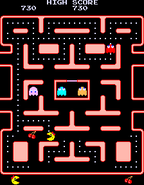
Arcade
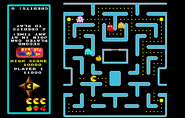
Arcade (Galaxy Games StarPak 2)
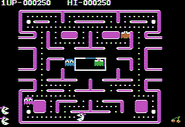
Apple II
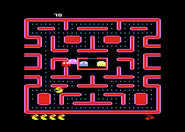
Atari 400/800/XL/XE
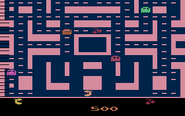
Atari 2600
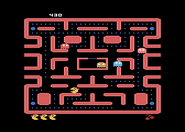
Atari 5200
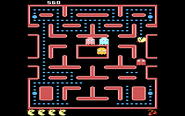
Atari 7800
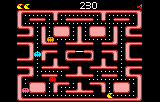
Atari Lynx

Commodore 64
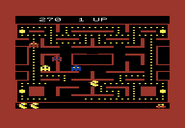
Commodore VIC-20
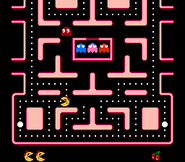
Famicom/NES (Tengen 1990 version)
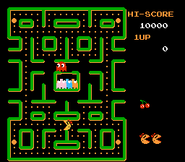
Famicom/NES (Namco 1993 version)
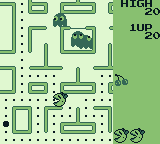
Game Boy (scroll mode)

Game Boy (full screen mode)

Game Boy Color (Ms. Pac-Man: Special Color Edition - scroll mode)
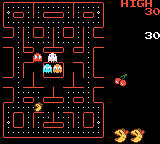
Game Boy Color (Ms. Pac-Man: Special Color Edition - full screen mode)
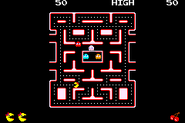
Game Boy Advance (Namco Museum - full screen mode)
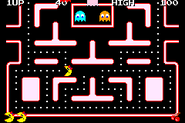
Game Boy Advance (Namco Museum - scroll mode)
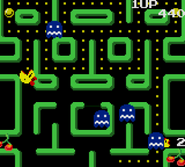
Game Gear
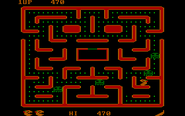
IBM PC (CGA RGBI mode)
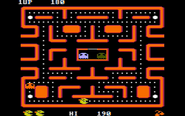
IBM PC (CGA composite mode)
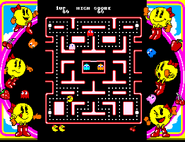
Nintendo 64 (Ms. Pac-Man Maze Madness)
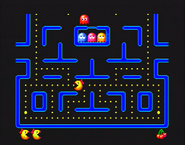
Phillips CD-i (Arcade Classics)
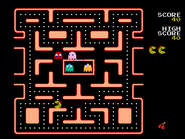
Plug 'N Play (Jakks Pacific Ms. Pac-Man Collection, 2004)
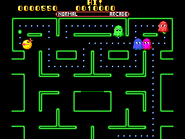
Sega Master System
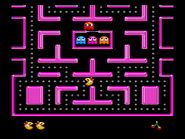
Sega Genesis/Mega Drive
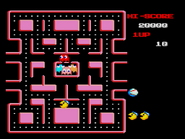
Sega Genesis/Mega Drive (Pac-Man 2: The New Adventures - Pac-Jr.)
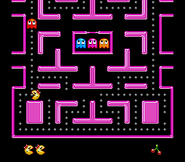
Super Famicom/SNES
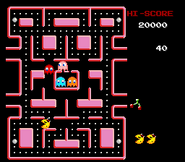
Super Famicom/SNES (Pac-Man 2: The New Adventures)
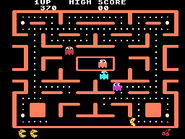
TI-99/4A
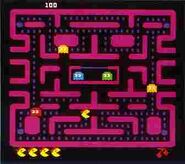
Unknown Atarisoft port (possibly BBC Micro)
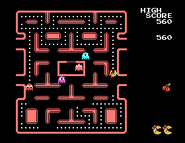
ColecoVision version made by Opcode Games in 2008.
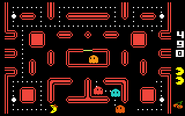
Intellivision version made by Carl Mueller Jr. in 2014.
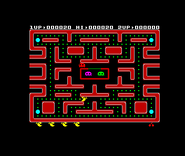
ZX Spectrum
Concept Artwork
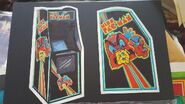
Early machine concept sketch.

Early machine concept sketch.

Early machine concept sketch.
Machine and Box Art
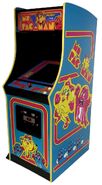
Original arcade machine.

Original marquee.
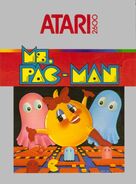
Atari 2600 box art.
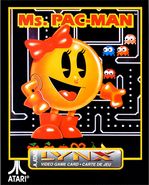
Atari Lynx box art.
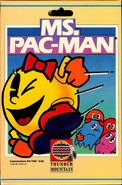
Commodore 64 box art.
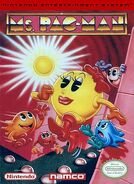
NES box art (Namco 1993 version).
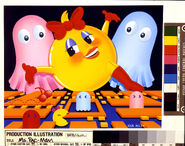
Full Atari 2600 artwork (production illustration).
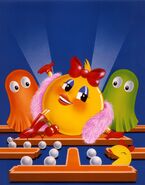
Full Atai 7800 artwork.
Character Artwork
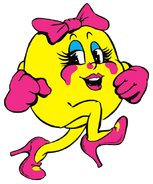
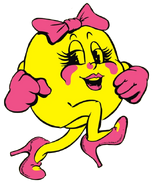
Ms. Pac-Man
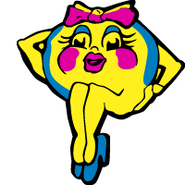
Ms. Pac-Man
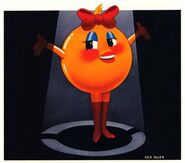
Ms. Pac-Man (Atari 2600 version)
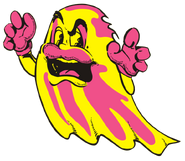
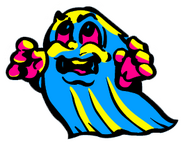
Ghost
External links
- From Ms. Pac-Man to Crazy Otto - for information on the many prototype versions of the game
References
- ↑ http://tk-nz.game.coocan.jp/gamedatabase/software/DB_ATM_LX1989-1991.html
- ↑ https://stat.ameba.jp/user_images/20190802/22/ponyponyex/b0/91/j/o0962130014520398913.jpg
- ↑ https://www.mobygames.com/attribute/sheet/attributeId,29/p,4/
- ↑ http://www.digitpress.com/faq/atarisoft.htm
| Pac-Man Games | |
|---|---|
| Maze Games | Pac-Man • Ms. Pac-Man • Pac-Man Plus • Super Pac-Man • Baby Pac-Man • Pac & Pal • Jr. Pac-Man • Pac-Mania • Arrangement (1996) • Pac-Man VR • Maze Madness • Adventures in Time • Quest for the Golden Maze • Pac-Man Vs. • Arrangement (2005) • Championship Edition • Championship Edition DX • Battle Royale • Pac-Man 256 • Championship Edition 2 • Party Royale |
| Platformers | Pac-Land • Pac-In-Time • Pac-Man World • World 2 • Pac 'n Roll • World 3 • Pac-Man Tilt • Ghostly Adventures • Ghostly Adventures (3DS) • Ghostly Adventures 2 |
| Others | Mr. & Mrs. Pac-Man • Professor Pac-Man • Carnival • Family Pinball • Puzzle Club • Pac-Attack • Pac-Man 2 • Pac 'N Party • All-Stars • Fever • Pac-Pix • Pinball Advance • World Rally • Pac-Motos • Party • Monsters |
| More... | List of Pac-Man games • Mobile games • Redemption games • Namco Catalog IP games |
Ms Pacman Game Boy Color Color Box Art
Source: https://pacman.fandom.com/wiki/Ms._Pac-Man_(game)
0 Response to "Ms Pacman Game Boy Color Color Box Art"
Post a Comment